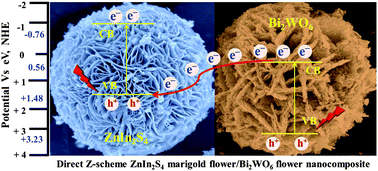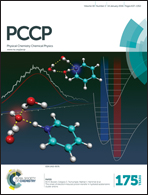Fabrication of hierarchically structured novel redox-mediator-free ZnIn2S4 marigold flower/Bi2WO6 flower-like direct Z-scheme nanocomposite photocatalysts with superior visible light photocatalytic efficiency†
Abstract
Novel, hierarchically nanostructured, redox-mediator-free, direct Z-scheme nanocomposite photocatalysts were synthesized via a facile hydrothermal method followed by wet-impregnation. The photocatalysts had a ZnIn2S4 marigold flower/Bi2WO6 flower-like (ZIS/BW) composition, which led to superior visible-light photocatalytic efficiency with excellent stability and reusability. The hierarchical marigold flower and flower-like morphologies of ZIS and BW were confirmed by FE-SEM and TEM analyses and further revealed that formation of the hierarchical marigold flower-like ZIS structure followed the formation of nanoparticles, growth of the ZIS petals, and self-assembly of these species. Powder X-ray diffraction and UV-visible diffuse reflectance spectroscopy analyses as well as the enhancement in the surface area and pore volume of the composite provide evidence of strong coupling between hierarchical BW and the ZIS nanostructures. The efficiency of the hierarchical direct Z-scheme photocatalysts for photocatalytic decomposition of metronidazole (MTZ) under visible-light irradiation was evaluated. The hierarchically nanostructured ZIS/BW nanocomposites with 50% loading of ZIS exhibited superior visible-light photocatalytic decomposition efficiency (PDE) compared to the composites with other percentages of ZIS and pristine BW. A probable mechanism for the enhanced photocatalytic efficiency of the ZIS/BW composite in MTZ degradation under visible irradiation was proposed. Radical quenching studies demonstrated that h+, ˙OH, and O2˙− are the primary reactive radicals involved, which confirms that the Z-scheme mechanism of transfer of charge carriers accounts for the higher photocatalytic activity. Kinetic analysis revealed that MTZ degradation follows pseudo-first-order kinetics and the reusability of the composite catalyst for up to four cycles confirms the excellent stability of the hierarchical structure. It is concluded that the hierarchical structure of the ZIS/BW photocatalyst, synergic effect, Z-scheme transfer of the charge carrier, high concentration of (˙OH) radical formation and the significant reduction in the charge carrier recombination account for the enhanced efficiency of the catalyst for photocatalytic decomposition of metronidazole by visible light under the present reaction conditions.



 Please wait while we load your content...
Please wait while we load your content...